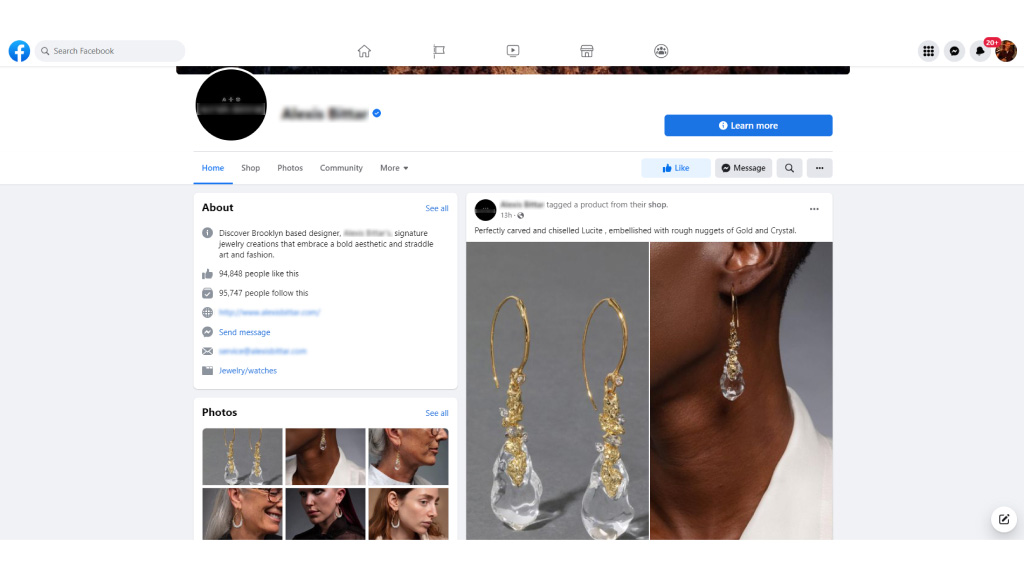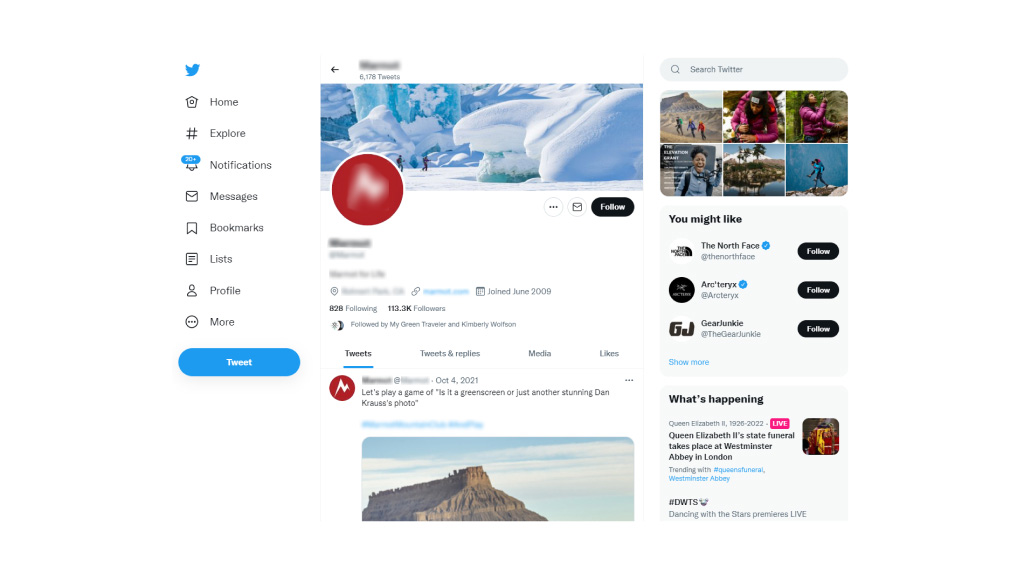
While you should definitely have a great eCommerce website which you can get by contacting one of the top BigCommerce web design companies, you also need some more online presence. Here’s our overview of the must-have social media for any business to help you get more customers as a part of your overall internet marketing strategies for eCommerce.
In eCommerce today, it’s well understood that your website is no longer just a platform for sales. Branding, Marketing, SEO, and customer service are essential aspects of your overall effective online presence. By deploying social media in harmony with your eCommerce site, you can extend the value of your products and services across multiple platforms. Drive qualified traffic, nurture leads and convert them to happy customers who promote your business ahead of the completion. So here are a few social media accounts for eCommerce businesses: Comrade Digital Marketing has curated a list of the four top social media sites that will benefit your eCommerce business’ bottom line sales.
Why Your Ecommerce Social Media Strategy Doesn’t Generate Sales
90% of social media strategies implemented by eCommerce companies fail because they don’t understand how social media works from a commerce perspective. Poor execution, bad timing, target audience misconceptions, and lack of social media marketing planning are common mistakes.
Whether you’re struggling to pinpoint why your social media posts aren’t converting or why you’re not getting the engagement you’d hoped for, our expert team has the answers. We’ll teach you how to use social media for eCommerce and get your strategy on track, saving you time and money while maximizing sales.
Delivering Business Results: Our Digital Marketing Case Studies
Facebook — Create and Customize Your Business Profile with Descriptions, Photos, and Videos
Considering virtually every business with a website also maintains a Facebook page, Facebook is still the king of social media. And it’s easy to see why. With well 829 million people using Facebook on a daily basis (an increase from 802 million last quarter), Facebook is the Internet’s “front page” for a vast population. It has become an electronic gathering ground where people socialize, find news articles, and – believe it or not – make purchases.

To create an optimized e-commerce Facebook profile, fill in all business details, use high-quality visuals, engage with your audience, and post relevant content
In fact, Facebook users bought $234 million dollars worth of virtual goods and gifts on Facebook over the last quarter and it drove more than 85% of purchases made through Facebook in 2014, making it our number one must-have social media account for eCommerce businesses. Not bad for a site people claim is “dying”.
Tip from a Digital Marketing Agency: Since Facebook has recently changed what content appears on the users’ feed page, make your brand posts more interesting so users will like your posts and you will appear in their feed.
Twitter — Register as a Member to Micro-Blog or “Broadcast” Short Posts Called Tweets

To create an optimized e-commerce Twitter profile, use a clear and compelling bio, include relevant keywords, engage with followers, and share valuable content
Twitter offers much of the same functionality for eCommerce businesses like Facebook. Twitter’s 750 million users look for companies who tweet short-burst, rapid, entertainment-oriented content. Commentary and opinion abound. Interestingly, Twitter makes the process of interacting with companies and other specific users very easy. 70 % of small businesses are on Twitter and 85% of followers reported feeling more connected with a business after following them. Successful companies can harness that goodwill and facilitate the spread of brand positives – all “on the fly” by an increasingly mobile generation of millennial consumers.
How Do You Actually Sell Ecommerce on Twitter?
You Don’t Sell — You Engage
Twitter social selling is a new process of selling that involves developing relationships as part of the sales process. Marketers laser-target their prospecting customers and establish rapport with them online. As a result, social selling enables better sales, lead generation and eliminates cold calling. In summary, eCommerce businesses take more time to listen to their prospect’s challenges and identify how their product or service can solve them before responding on the platform.
Build Your Ecommerce Store Account
If you wonder how to use Twitter as a brand, the first step is to Tweet. Participate in conversations, share useful content and engage with prospects. Group users and accounts via lists to track different trends. Retweet and follow others to increase your Twitter presence. You don’t have to have a large following, to begin with, but you do need a strategy.
When tweeting content or responding to a lead, be specific and address their concerns. Twitter is a personalized platform where audiences can immediately tell if your Tweet is disingenuous, and they’ll be quick to call you out. It also assures potential leads that you aren’t using bots.


Monitor Your Mentions
Successful eCommerce selling on Twitter requires brands to monitor their company’s mentions, as these will provide valuable feedback on common queries and concerns customers have about your service or product. @mentions can be monitored by typing your company’s account in the regular search bar.
It’s equally important to reply to @mentions as this nurses customer relationships and builds credibility, especially if they are related to customer service concerns. However, if your company receives too many @mentions, consider employing an agency or community manager to handle your social media.
Link Other Socials and Your Ecommerce Store
Selling on Twitter can be challenging because of its 280-character limit, which prohibits longer conversations. So while Twitter DMS are useful, your end goal should drive conversations from social media to your website to engage with content or make a purchase, depending on how far down the buyer’s funnel your lead is.
Twitter is an excellent platform to augment selling efforts and build a network of relationships to convert into leads. Its interface makes it easy to retweet or like something and stays on users’ radars. But ultimately, you want to drive them towards a call-to-action.
Follow Ecommerce and Other Trends
Twitter hashtags (#) give tweets context and prolongs conversation longevity. This social media platform shows users topics and conversations that a trending via hashtags. For example, when users add a “#” to the beginning of an unbroken word or phrase, it links it to all other Tweets that include it. In some instances, it provides invaluable marketing opportunities.
For example, the famous Lay’s Do Us a Flavor campaign where the potato chip brand asked social media users to vote for their favorite new flavor. Not only is it excellent market research, but it also boosts brand-customer relationships and visibility. However, hashtags aren’t the only trends to cash in on, which is why it’s important to keep abreast of the way potential leads use social media.
If You’re Still Not Convinced That Twitter Can Positively Affect Your Business, Check Out These Statistics:
- 67% of Twitter users are more likely to buy from the brands they follow on Twitter
- 42% of consumers learn about new products and services via Twitter
- 63% of people follow Small Business to show their support for them and promote their content to their followers, aka: potential new customers.
Google+ — Replicate the Ways in Which People, Ecommerce Business Owners Included, Interact Offline
Their mantra: “Real-life sharing rethought for the web.”
Even with 90 million users, Google+ has not become the Facebook-killer for which Google had hoped. However, it continues to gain followers due to the search giant’s ability to leverage products and services in an onslaught of complimentary offers to eCommerce businesses.
While it may feel redundant to add a Google+ account to your company’s longstanding Facebook account, the SEO advantages you will enjoy far outweigh the hassle. Because sites are already indexed by Google, if you have a Google + page, they will show you a little favoritism by expediting your indexing process. Naturally, Google privileges its own social networking site when determining page ranking (especially over Facebook. They’re a little bitter). Read our blog post about Google+ effectiveness. As a Chicago SEO company, we follow Google+ trends very closely.
Pinterest — Upload, Save, Sort, and Manage Images and Videos
Images are electronically placed on “pinboards” to showcase products and services for sale via your business’ eCommerce.
Pinterest brings the intrigue and fun of department store shopping to the era of eCommerce. The minimalist, visually oriented design of the site allows users to browse various products across brands and stores without the pressure of being “sold to” in a more formal sales environment. In fact, 93% of Pinners shopped online in the past six months. For many businesses, Pinterest is only second in visitor count, lead conversion, and online sales to powerhouse Facebook.

One of the biggest benefits of Pinterest is the fact that the number of people who see your pins is greater than your number of followers. This means a potential customer does not have to be following you to be exposed to your message and promoted pins perform long after campaigns end. As a web design agency, we recommend using a Pinterest channel to many of our Clients that sell directly to consumers.
Advanced Social Media Marketing Tactics for Explosive Ecommerce Growth
What You Need to Know about Social Commerce
Social media networks move at a lightning pace. The mistake most eCommerce businesses make is getting caught up in new features, algorithm updates and improved user experience, instead of viewing these platforms as just another set of channels to acquire customers and promote and sell products.
An advanced eCommerce social media strategy isn’t about tweaking a small element on a post, or even about your budget. It’s actually more about thinking like a strategist and using battle-tested frameworks and social media best practices to develop long-term and profitable customer relationships.
Mastering a few basic concepts can take your social media advertising to the next level, and our team at Comrade Digital Marketing is here to tell you exactly how it’s done.
What Your Social Media for Ecommerce Should Prioritize
A strategist’s first focus is generating a sale—not to make a profit but to acquire a customer. Every business, whether big or small, depends on customers to survive. A strong and loyal customer base increases recurring revenue and allows you to initiate a strong sales plan.
There are three main pillars you should focus on to improve social selling—customer acquisition, average order value and customer lifetime value.
1. Set Social Commerce Objectives
You need to set SMART goals, i.e., ones that are specific, measurable, attainable, relevant and time-bound. If you’re focussing on sales, your goal might be, “we want to increase sales by 200% this year.” Keeping goals clear and simple gives your social commerce strategy a direction.

An effective strategy always has measurable goals. Many businesses make the mistake of saying they want to increase sales or generate leads, but don’t specify any numbers, which makes it difficult to track progress and accelerate strategies.
2. Develop a Social Media Plan
A social media plan is a summary of everything you plan to execute and hope to achieve on social media. It determines your target audience, the social networks to join, and the type of content to develop and share.
The more specific you are, the more effective your plan will be. Social media plans are usually applicable for at least a year, so it’s good to keep this in mind when setting your goals and quarterly KPIs.
Examples of meaningful goals include increasing brand awareness, generating leads and sales, and improving community engagement. Remember, you can have more than one goal! An expert digital marketing company can help you refine your plan to ensure your social media platform use aligns with your business objectives.
3. Set Your Budget
The first resource you need to achieve your eCommerce social media marketing goals is a budget. Remember, your budget is not just the amount you spend on social media advertising, but also how much you’re willing to invest in content creation and software tools.
Businesses typically spend around 20% of their total marketing expenditure on social media. It’s important to set a budget early, so you can strategize accordingly and have the right expectations about what’s achievable.
During this time, also consider what marketing matrix you’ll use to determine whether your strategy is making the right progress. A marketing matrix is the combination of product, price, place, and promotion for a business. It will help you optimize your online tactics for the highest possible growth.
Once you’ve figured out the details, you’ll want to monitor and measure your progress, so you can adjust and optimize your social media strategy when necessary.
4. Improve Customer Acquisition
Social media for eCommerce operates as an organic and paid customer acquisition channel. However, simply garnering a bunch of “likes” on your social media profiles isn’t enough to drive the sales you need.
To transform leads into life-long customers you first need to have a solid grasp of who your target audience is, and then communicate in such a way that appeals to them, i.e., have a customer acquisition plan. Implementing an acquisition marketing strategy that specifically targets prime candidates already interested in your products and services is ideally the best way to get new customers.
We recommend starting with the 80-20 content rule. Use 80% of your content to inform, educate or entertain your audience, and the other 20% to promote your brand and sell your products.
Comrade Digital Marketing Agency can help you with the above if you’re unsure how to go about it. Schedule a free consultation.
5. Maximize Average Order Value
The average order value is the average dollar amount spent each time a customer places an order. To maximize your average order value, there are two key tactics to consider—cross-selling and upselling.
Cross-Selling
Cross-selling is the process of encouraging customers to purchase products or services in addition to the original items they intended to buy. Often, these items are complementary, giving customers more of a reason to purchase both. Common tactics include offering discounts on product bundles and promoting secondary items essential to a product’s performance.
UpSelling
Unlike cross-selling, upselling is when you increase a customer’s cart value by prompting them to select a more expensive version of the product they want to buy. This is one of the quickest ways to increase the average order value.
To be successful in both upselling and cross-selling, you have to understand what your potential customers are looking for and offer them products at the appropriate time. Having distinct buyer personas and a clear buyer’s journey goes a long way to support these tactics.
Have a Strategic Product Line
Selling closely aligned products is another way to maximize average order value. This means having products that easily build on one another, so customers quickly understand why they want to add additional items to their carts. Make-up product lines are a good example. A customer who purchases a face wash can easily be tempted to buy toner and moisturizer, and so on.
6. Increase Customer Lifetime Value
Customer lifetime value (CLV) is the total worth to a business of a customer over the whole period of their relationship. A true marketing strategist will advocate for outspending competition on acquisition costs if they know they can maximize the order value of every sale and number of transactions.
Investing in social ads, sharing user-generated content and providing excellent customer service across social platforms improves the chances of increasing CLV. Your goal isn’t necessarily to convince customers to buy your products or services but rather to build their affinity for your brand by engaging them through their social media accounts.
How to Calculate Your Current CLV
Bear in mind your CLV will vary by different customer segments. For instance, some segments may have a higher CLV because those customers spend more per transaction or because they have been purchasing from your brand for longer.
To calculate general CLV, you’ll need the following data:
- Average purchase value—the value of all customer purchases over a particular timeframe (typically a year), divided by the purchases in that period.
- Average purchase frequency—divide the number of purchases in that same period by the number of individual customers who made a transaction during the same period.
- Customer value—the average purchase frequency multiplied by the average purchase value.
- Average customer lifespan—the average length of time a customer continues buying from you.
Once you’ve got this data, you can calculate customer lifetime value:
CVL = customer value x average customer lifespan
The result is a monetary value that shows how much you can reasonably expect the average customer to spend with you over their lifetime. Ideally, you want the value to be higher than your average order value, indicating you’ve sold to the same customers several times.
If not, you have an opportunity to work on maximizing the number of transactions made by your current customer base.
How to Use Email Marketing to Boost Customer Lifetime Value
Customer lifetime value is one of the most important eCommerce metrics because it provides a picture of your business’s long-term financial viability. High CLV is a good indicator of product-market fit, brand loyalty, and recurring revenue.
To increase CLV, you need continuity of products that customers will continue to buy through the years. There are two ways you can promote your products—through social media and email. You can use social media to direct customers to a lead capture form in exchange for a resource or discount.
Once you have their contact details, their email addresses transform into direct communication channels. Brand emails can be incredibly effective in terms of conversions and cost. Think of how many emails you can send in a year! Emailing once a week equates to 52 emails, i.e., 52 reminders to customers they should come back and buy more.
Social Media for Ecommerce and the Marketing Funnel
A strong social media marketing strategy integrates with the four main sections of the marketing funnel: discovery, intent, conversion, and loyalty. Your social media funnel should map out how potential customers become aware of your brand, consider it, make a purchase, and then go on to become loyal customers and brand advocates.
Customer acquisition, average order value and lifetime value form part of this funnel. You can’t improve any without understanding how your customers move through the different phases, after which you can tailor content to meet them at whichever stage they’re at.
Underpinned by an understanding of their target audience, advanced social media marketers understand the interplay between these different facets and how social media platforms play an integral role in powering the sales process.
Top Two Social Media Marketing Mistakes
The two most widespread mistakes we see on social media are:
- Focussing too much on sales with no real strategy; and
- A lack of consistency.
You can’t tweak social media campaigns and optimize sales without getting the fundamentals right first. Fixing these two things will improve engagement and ROI across multiple social media platforms.
1. A Sales-Only Approach
One of the biggest misconceptions about social media platforms is they’re meant to bring you sales. Social media networks are full of businesses trying their utmost to sell to audiences that aren’t listening. This is because social media should primarily be used to build brand awareness and connect with your target audience.
Imagine if your favorite brand only shared hard-sell advertising messages with their latest products and prices. No doubt, you’d get bored and disengage. Yes, your online store needs eCommerce sales, but customers have to deem your brand trustworthy before they make purchases.
If you saw a company had a poor social media presence or no presence at all, then you’d think twice before buying something. So, how do you build trust? By developing a strong online presence, bolstered by social media.
Social media allows you to exercise your expertise and establish a relationship with your target audience through the content you share and the community you build. That doesn’t mean you can’t use paid advertising on social networks, but rather that it shouldn’t be the sole focus.
2. Inconsistent Engagement
For your audience to recognize your brand, you must be consistent. Keeping with a regular social media strategy creates a better customer experience and builds credibility, reputation, and brand trust.
To achieve consistency, you need a content calendar. These schedules typically include upcoming content pieces, status updates, planned promotional activity, partnerships, and updates to existing content, as well as which platforms you aim to share content on.
Social media platforms are flooded with ad campaigns and visual content. One post a month definitely won’t cut it with so many social media accounts out there. Instead, set a goal to engage with social media users a few times a week, aiming for daily interactions with your audience.
Your social media profiles provide existing and potential customers with live PR updates, helping them keep in touch with your eCommerce store. This maintains an engaged audience and develops interpersonal relationships that lead to brand loyalty.
How Social Media Grows Brand Loyalty for Ecommerce
Companies that score high on customer loyalty grow revenue 2.5 times faster than their industry peers. However, eCommerce stores currently competing in heavily commoditized sectors find themselves engaged in an increasingly tough battle to win loyal customers.
eCommerce customer loyalty is not dependent on price but on the perceived perception of higher quality and better service than competitors. If digital marketing shapes customers’ perceptions of a brand, then social media is the perfect place to develop these perceptions.

You can’t build customer loyalty without customers. And where do you find the most loyal customers? Social media platforms! These are the easiest channels to foster positive customer relationships and build an engaged and loyal community of brand advocates.
Read on to learn how using social can increase customer loyalty and consequently lower customer acquisition costs.
Why Is Brand Loyalty so Important for Ecommerce Stores?
Customer loyalty equals repeat sales. Prioritizing customer retention is a smart financial decision for any profitable business because finding new shoppers costs six to seven times more than retaining existing customers. In short: eCommerce brand loyalty drives growth. You need customers to continuously buy from you to maintain cash flow and make a profit.
The majority of customers are willing to pay more to brands that meet their needs. Therefore, cultivating customer loyalty is the first step to improving customer lifetime value. Satisfied customers who are loyal are one of your company’s biggest assets. Providing great customer service isn’t good enough anymore. Now you need to harness the power of social media to build an engaged client base that supercharges sales.
5 Tips to Improve Ecommerce Customer Loyalty
An essential component of building brand loyalty is being able to meaningfully connect with customers. Some eCommerce businesses’ social media accounts can feel impersonal. To avoid your messaging from sounding like an online loudspeaker, you can follow our pointers below.
1. Communicate with Customers
Most people dislike being spoken at. Instead, think of your social media marketing as continuous dialogue with your follower and customers. To be truly social to build brand loyalty, you must be willing to respond to social media users who take the time to engage with your company for better or worse.
79% of customers expect a response to their social media posts within 24 hours. So, when a customer asks a question or leaves a review, respond in a timely manner. Ignoring customers simply produces a negative experience. Many eCommerce businesses employ a community manager for this reason or use chatbots to maintain excellent customer service.
2. Reach Out to Customers after a Sale
Providing after-sales services shows you value your customers, and encourages repeat purchases. It’s also easier to turn a well-served customer into a brand advocate. Sending customers a strategic email goes a long way in improving customer service and increasing brand loyalty.
Your email might ask them the following:
- How was your shopping experience?
- Do you like the product?
- Did you receive it on time?
- Is there anything we could have done differently or better?
Even if a customer doesn’t respond, at the very least, they’ll appreciate the time you took to follow up and improve customer satisfaction.
3. Transform Loyal Customers Into Influencers with UGC
According to research, 86% of people aged 13 to 38 years old would like to become a social media influencer. The idea of being an influencer is appealing because it confers celebrity status to ordinary people. Smart brands leverage this desire to build customer loyalty.
By asking followers to create user-generated content or UGC, they bestow influencer status on their loyal customers. Using UGC content makes those customers feel appreciated and also gives your company more marketing collateral while increasing customer engagement.
You can go the extra mile by reposting their content, tagging their profiles, and thanking them for supporting your brand. This creates a personalized brand experience and makes customers feel included which encourages repeat business.
4. Collaborate with Professional Influencers
Professional influencers have large followings, so when they endorse your product or service, they expose your eCommerce store to new customers and increase brand trust. Although most of these collaborations come at a price, influencers have a range of experience creating branded content, so unlike UGC content, you can expect their content to be high quality.
If you choose the right influencers, you’ll make good ROI too. This is because they know their audience and can tell you the average engagement you can expect from their content. Consumers want quality content, and they’re more likely to buy from brands endorsed by online celebrities they recognize.
5. Give Away Freebies
Freebies work because they leverage the power of reciprocity. They also add value to customer interactions and cultivate positive feelings about your brand. When a freebie is paired with a full-priced product, it’s believed to increase the perceived value of the product or service as a whole. This unexpected and seemingly underserved addition to a purchase helps increase brand loyalty because it demonstrates an eCommerce store’s ability to go above and beyond.
Remember, freebies don’t have to be tangible goods. Free shipping, discount offers, “buy-one-get-one-free” offers and loyalty programs all utilize freebies to drive eCommerce customer loyalty. Giving away free things is also a fantastic lead magnet strategy to help you gather customer contact details, so you can get prospects interested in your brand to enter the marketing funnel.
Conclusion
Depending upon the social-savvy qualities of people in your industry, you will achieve better results on some platforms compared with others.
For antiques and collectibles, for instance, Pinterest and Instagram drive more sales than Facebook or Twitter. Digital products—from electronics to appliances—on the other hand, sell much better when product endorsements appear on Reddit or YouTube.
Ultimately, social media is a tool to help you reach and interact with your customer base. When you understand and honor what your customers want and like, you are halfway to creating engaging content that boosts your business’ bottom line.
Analyzed properly, it will also provide a treasure trove of insights into your customers’ behaviors and purchase patterns that would be impossible to know, fewer than ten short years ago.
Once you’ve followed these steps, you can put your eCommerce social media strategy into practice. Before doing so, why not contact Comrade Digital Marketing for an in-depth digital marketing audit? We work with many clients as their digital marketing partners to boost eCommerce sales in real-time.
Frequently Asked Questions
Where do you operate?
Comrade originates in Chicago, but we worked all around the United States. We can help your business grow and increase revenue whenever you are. We have offices across most major cities in the US. For example, we can offer digital marketing services in Madison or Atlanta. You can even find our internet marketing experts in Seattle! If you want to know more about our Baltimore digital marketing agency or find out how exactly we can help you, contact us via the phone or email.








